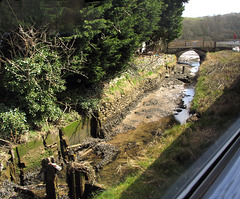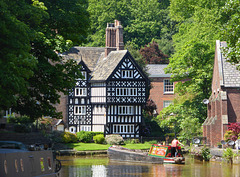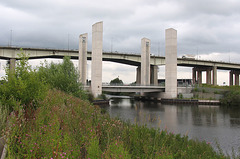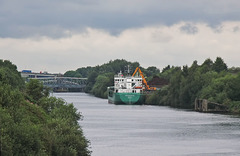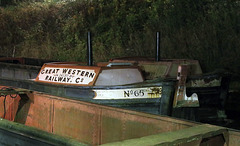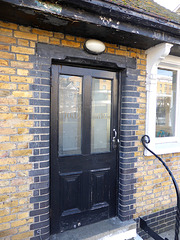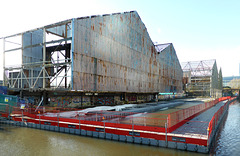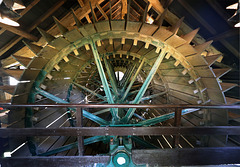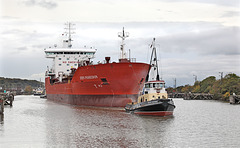
Canals
River Lock
| |
|
|
|
The Liskeard & Looe Union Canal was completed in 1828 between the East Looe River and Moorswater. The intention was to carry sea sand lime and coal up into the rural districts for agricultural improvement. Trade was boosted in the mid 1840s by copper ore coming down from the Caradon mines and granite from Cheesewring Quarry. The building of the Liskeard and Looe Railway made the top section of the canal unusable and trade steadily declined on the lower end until final closure in 1910. This is the river lock at Terras seen from a passing train. Remnants of the gates can still be seen after over one hundred years since closure.
Salterhebble
| |
|
|
The tarboat is leaving the top lock at Salterhebble on the Calder & Hebble Navigation. This is definitely the eastern limit for the boat as it is around 13ft longer than the lock! It was a bit of fun to take the boat to the very furthest point it could get.
Tarboat at the turn
| |
|
|
Former Thomas Clayton tanker narrowboat Spey makes the turn onto the Leigh branch of the Bridgewater Canal at Worsley. More satellite dishes than GCHQ on the right keeping the locals entertained.
Barton lift bridge
| |
|
|
This bridge over the Manchester Ship Canal was constructed for Peel Land and Property and carried the A57 over the Manchester Sjip Canal. During testing in May 2016 the lifting equipment failed on the west side and the deck crashed down. This delayed the opening until the end of 2017 and the repaired concrete on the pillars is still obvious.
Howard Civil Engineering carried out civils works for the bridge with Cass Hayward as designer.
Scrap
| |
|
|
The 2998gt ship Arklow Raven is loading scrap at the European Metal Recycling Irwell Park Wharf on the Manchester Ship Canal. Visible in the background are Barton Swing Aqueduct, Barton Swing Bridge and Barton High Level Bridge.
Railway boats
| |
|
|
Night shot of day boats in the canal arm at the Black Country Living Museum. These narrowboats were used around the Birmingham Canal Navigations and the Great Western Railway owned boats would have been employed moving goods to and from a number of interchange basins owned by the railway company. These are referred to as day boats as they were not lived on as a matter of course unlike the long distance narrowboats. The cabin is smaller than on the latter vessels and provided some shelter and a stove for warmth. The boatmen would usually go home at night as they would never be far from there on the Birmingham Canals. Occasionally they would spend a night on the boat but this was not the usual practice.
The initials TB & Co on the rudder or elum are thos of Thomas Bantock & Company. Bantock became boatage agent to the recently completed Oxford Worcester and Wolverhampton Railway in 1853 and then to the Great Western Railway in 1855 dealing with canal wharf to rail transfers. In 1858 he set up a business as Thomas Bantock and Company with offices within the Great Western Railway station at Wolverhampton. He was appointed as ‘carrier’ for the Wolverhampton District. The agency was for: ‘carriage of rail-borne goods by road less than 40 miles along a route taken between places within a 25 mile radius of Wolverhampton Low Level Station’. He was paid a percentage of the GWR charge to customers. The cartage agents, as later referred to, were required to provide suitable vehicles, in an approved livery, horses and harness and employ civil, energetic men to the GWR Company’s satisfaction.
In 1860 Bantock owned 51 canal boats working from GW/OWW transfer wharves on the Birmingham Canal Navigations (BCN). In 1861 he was still the Duke of Bridgwater’s Trustees District agent too. Bantock boats were based throughout the Black Country including 5 boats at Stourbridge (1858 to 1956) and 3 at Stourport. The Great Western had its own narrow boats working on the BCN and in 1866 Bantock hired 16 boats from the GWR at £15 per month. Thomas Bantock and Company expanded their interests becoming an ironmaster, coal mining (Ettingshall Lodge Colliery, Springvale 1865-90), and boat builder at Ettingshall Dock, Millfields. They built for themselves and the GWR completing 116 boats by 1895. They were said to have built their own railway wagons at the same works. The Company offices were now based at the rear of Albion Wharf at Herbert Street, Wolverhampton.
Tarboat on the move
| |
|
|
|
Ex Thomas Clayton tanker Spey takes the turn under the old railway bridge between locks 11 and 12 at Bosley on the Macclesfield Canal. The boat was built in 1937 at Uxbridge and spent its career moving gas oil from Ellesmere Port to Oldbury and also gasworks byeproducts around the West Midlands. It has been in preservation since the 1960s.
Maintenance boats
| |
|
|
A pair of maintenance boats built for duties on the Ashton, Peak Forest and Macclesfield Canals. Maria was built by Jinks at Marple in 1915 at a cost of £155. It replaced another boat of the same name built at the same yard for the Buxton Lime Company.
Joel was originally built as a horse boat for the Buxton Lime Company in 1918. Sold out of service to the London and North Eastern Railway Company in 1926 she was subsequently rebuilt in 1929 as a motor boat fitted with a Kelvin 9HP petrol engine. This was the first motor boat in the maintenance fleet and always betrayed its' origins as a horse boat through the short, low horse boat style cabin cum engineroom with no gunwhales and the long rear deck and consequent long tiller. By 1946 the boat was in need of rebuilding and it was replaced by a new motor boat built at Gorton. It entered service in British Waterways colours in August 1948, retaining the fleet number 9. It may well be that a number of parts from the original boat were incorporated in the new Joel and that for accountancy purposes it was actually classed as a rebuild rather than a new boat. The boatbuilder at Gorton at this time, one Tommy Challinor, is said to have lacked the confidence to build a new boat from scratch and consequently always rebuilt or modified existing boats so they were like the aged broom that had 3 handles and 4 heads. Powered by a new 15hp twin cylinder Kelvin petrol/paraffin engine this was a fast boat which served until the Ashton canal became derelict in the early 1960's.
Both boats were abandoned on the Ashton Canal by the early 1970s but were rescued by enthusiasts who formed the Ashton Packet Boat Company and undertook extensivel rebuilds. They continue to keep these rare wooden narrowboats in good order.
Toll Office
| |
|
|
Etched glass in the door of the former toll office at Brentford Gauging Lock on the Grand Union Canal.
Floating dock
| |
|
Bantam tug docked on a barge at Bulls Bridge close to the start of the Paddington Arm of the Grand Union Canal.
Winter boating
| |
|
|
Taking the tarboat down the Hanwell locks towards Brentford. It was a very cold day when we experienced gales, hail, thunder, rain and sun.
Moore swing bridge
| |
|
|
|
Moore Lane swing bridge over the Manchester Ship Canal at Moore. It now provides access to a large nature reserve.
Brentford warehousing
| |
|
I grabbed this shot of the remaining corrugated iron fascia of the canal warehouses at Brentford as I passed by boat. The floating pontoons are to keep the public using the towpath well away whilst the site is redeveloped. The next week all these structures were dismantled and demolished. No doubt apartment blocks will arise in double-quick time.
Waterwheel
| |
|
|
Inside the waterwheel at Claverton pumping station which uses the power of the River Avon to raise water 48ft into the Kennet and Avon Canal. It opened in 1813 and is still capable of undertaking the same work today although now operated only on certain days under preservation. Recently the discovery of a crack in one of the arms of the waterwheel has precluded use until repairs can be undertaken.
Caisson House
| |
|
|
Caisson House and the bridge above lock 5 of the Combe Hay flight of the Somerset Coal Canal. The grade II listed house is named after Robert Weldon's Caisson Lock which, along with two others, was intended to remove the need for a flight of 22 locks and consequent great use of water. The first caisson was constructed in 1796 but suffered significant operational difficulties which culminated in the Canal Committee being trapped within when it became stuck during operation. This led to the caisson idea being abandoned and an inclined plane was substituted until the conventional locks were built.
Stanlow cooling
| |
|
|
A small part of the Stanlow chemical complex viewed from the Manchester Ship Canal close to the Boat Museum in Ellesmere Port. This view includes part of the Innospec plant which manufactures fuel additives and, according to its website, is the world's only manufacturer of tetraethyl lead products.
Sten Poseidon
| |
|
|
2007 built oil/chemical tanker Sten Poseidon attended by tug MSC Victory with MSC Viking at the stern is leaving the locks at Eastham on the Manchester Ship Canal bound for Stanlow.
George
| |
|
|
The short boat George was built in 1910 to carry coal for the Wigan Coal & Iron Company. This is now the sole survivor of the transom-stern boats commonly used on the Leeds & Liverpool Canal. After it finished working on the coal trade in Lancashire the boat was saved for the Boat Museum at Ellesmere Port where it remains after a major rebuild in 2016. This view shows the transom stern as it was in 2003 in the livery of its original owners.
Jump to top
RSS feed- Latest items - Subscribe to the latest items added to this album
- ipernity © 2007-2024
- Help & Contact
|
Club news
|
About ipernity
|
History |
ipernity Club & Prices |
Guide of good conduct
Donate | Group guidelines | Privacy policy | Terms of use | Statutes | In memoria -
Facebook
Twitter

